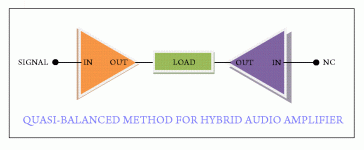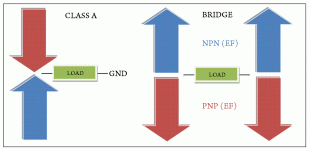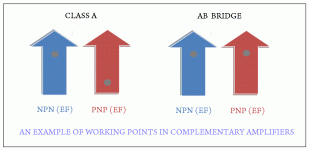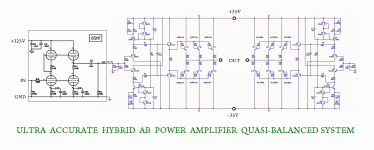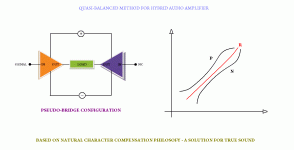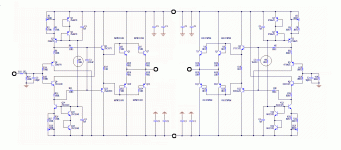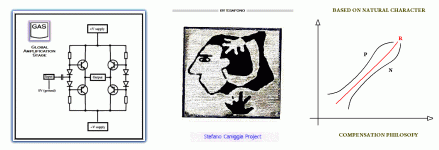Hi
my new Hybrid amplifier works with a particular system
preamplifier is a SRPP of 6SN7
amplifier are double on each channel (Lite A-680 DIYGENE) in bridge
but "Cold" amplifier don't have signal in input - Not Connected
sounds GOOD
http://www.esafono.it/quasi_balanced.htm
my new Hybrid amplifier works with a particular system
preamplifier is a SRPP of 6SN7
amplifier are double on each channel (Lite A-680 DIYGENE) in bridge
but "Cold" amplifier don't have signal in input - Not Connected
sounds GOOD
http://www.esafono.it/quasi_balanced.htm
Attachments
Last edited:
...in bridge but "Cold" amplifier don't have signal in input - Not Connected
sounds GOOD]

[snip]
amplifier are double on each channel (Lite A-680 DIYGENE) in bridge
but "Cold" amplifier don't have signal in input - Not Connected
sounds GOOD
http://www.esafono.it/quasi_balanced.htm
So why is it there? Why not just ground that side of the load?
jd
Because he was afraid that it could look even more uninventive (I have to resist to write more appropriate words)!So why is it there? Why not just ground that side of the load?
jd
Because he was afraid that it could look even more uninventive (I have to resist to write more appropriate words)!
Well he must have a reason, maybe it is a good one. I looked at his website but couln't figure it out, my Italian isn't that good.
jd
ghost Stage instead ground
The compensation of the "character" of bipolar devices in complementary symmetry amplifiers
Normally occurs with the overlap of the curves PNP and NPN entire waveform:
Class A inappropriately use the method of complementary
. Because it does not comply with the direction of the curve.
To obtain an accurate compensation is required
Synchronizing the operating point of the two curves P and N
In the direction of work (increase / decrease) consistent.
This consistency in the pattern of vectors is "Bridge" or Balanced (Class AB)
To obtain an excellent result with the Class AB balanced (or bridge)
It requires, however, a perfect symmetry of the signals between the hot and cold branch.
Quasi-Balanced configuration is not bound by this requirement
As the signal is single (unbalanced) then the amplifier "cold"
It acts passively by providing current as a function of the amplifier "hot"
(to maintain balance in the DC voltage)
Making a component Tonal balance seemingly useless
But can cancel like a mirror with great accuracy the emphasis of the components.
(Google translator)
The compensation of the "character" of bipolar devices in complementary symmetry amplifiers
Normally occurs with the overlap of the curves PNP and NPN entire waveform:
Class A inappropriately use the method of complementary
. Because it does not comply with the direction of the curve.
To obtain an accurate compensation is required
Synchronizing the operating point of the two curves P and N
In the direction of work (increase / decrease) consistent.
This consistency in the pattern of vectors is "Bridge" or Balanced (Class AB)
To obtain an excellent result with the Class AB balanced (or bridge)
It requires, however, a perfect symmetry of the signals between the hot and cold branch.
Quasi-Balanced configuration is not bound by this requirement
As the signal is single (unbalanced) then the amplifier "cold"
It acts passively by providing current as a function of the amplifier "hot"
(to maintain balance in the DC voltage)
Making a component Tonal balance seemingly useless
But can cancel like a mirror with great accuracy the emphasis of the components.
(Google translator)
Attachments
To obtain an excellent result with the Class AB balanced (or bridge)
It requires, however, a perfect symmetry of the signals between the hot and cold branch.
This is wrong. The math is simple and probably easy to find in www. land.
Attachments
I see what you mean. Interesting thinking, but I am not sure it works that way. Let us suppose that the driven amp has the 'N' curve. This curve is the result of several things, like non-linear amplification and non-zero output impedance.
The not-driven amp only has an error due to it's non-zero output impedance because it is not driven. Why would that error be the exact complement of the non-linear amplification of the N part?
jd
the current flow
really this amplifier in picture don't have internal feedback
and my working double amplifier have it (A-680)
but the concept is the same
the current in N channel and P channel in one half wave
must be the same
so the same working point in the same direction
for that reason is better then Class A
(different point in different direction)
and better then Balanced AB
becuse signal is exactly the same - like two tube in SRPP
really this amplifier in picture don't have internal feedback
and my working double amplifier have it (A-680)
but the concept is the same
the current in N channel and P channel in one half wave
must be the same
so the same working point in the same direction
for that reason is better then Class A
(different point in different direction)
and better then Balanced AB
becuse signal is exactly the same - like two tube in SRPP
Attachments
need an internal feedback on each stage
but also without
we can say the current is the same in opposite P and N devices
so the imprinting is near the same
for sure much better then complementary Class A
You didn't answer the important question(s):
Why would the two 'errors' in the two halves be exactly the same in magnitude and phase?
Why would they be of opposite polarity?
Without this, it is all speculation and wishfull thinking.
jd
for the shape you can see datasheet
zoom in linear zone - are specular
about amplitude - the reason is the current
it's the same
So the current is the same - so what? It is the product of current and impedance that generates the voltage. You still haven't answered the questions why these two curves would be the same in magnitude and phase and also be exactly opposite.
What datasheet do you refer to?
jd
Stee,
as usual, you have established nothing.
He can join your club.
- Status
- This old topic is closed. If you want to reopen this topic, contact a moderator using the "Report Post" button.
- Home
- Amplifiers
- Solid State
- Quasi-Balanced Method
